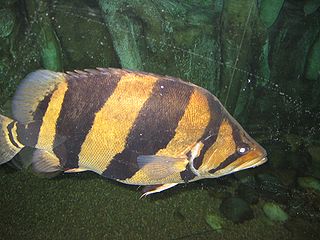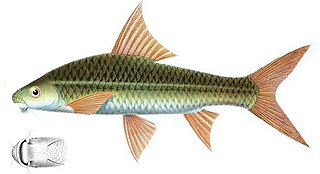
The Mekong or Mekong River is a transboundary river in East Asia and Southeast Asia. It is the world's twelfth-longest river and the third-longest in Asia with an estimated length of 4,909 km (3,050 mi) and a drainage area of 795,000 km2 (307,000 sq mi), discharging 475 km3 (114 cu mi) of water annually. From its headwaters in the Tibetan Plateau, the river runs through Southwest China, Myanmar, Laos, Thailand, Cambodia, and southern Vietnam. The extreme seasonal variations in flow and the presence of rapids and waterfalls in the Mekong make navigation difficult. Even so, the river is a major trade route between Tibet and Southeast Asia. The construction of hydroelectric dams along the Mekong in the 2000s through the 2020s has caused serious problems for the river's ecosystem, including the exacerbation of drought.

The Siamese tigerfish, also known as the Siamese tiger perch, is a species of ray-finned fish belonging to the family Lobotidae, the tripletails and tiger perches. This fish is endemic to Indochina and is assessed as Critically Endangered by the IUCN.

Lobocheilos is a genus of fish in the family Cyprinidae native to Asia.

The bronze featherback is a ray-finned fish in the family Notopteridae found in South and Southeast Asia. Although primarily found in fresh water, it has been known to enter brackish water. At present, it is the only member of the genus Notopterus, but as currently defined, it is likely a species complex.
Systomus jacobusboehlkei is a species of cyprinid fish native to the lower Mekong and Chao Phraya Basins of Cambodia, Vietnam, Laos, and Thailand. It inhabits marshlands and floodplains, swamps, and small, slow-flowing tributaries. It is present in local food fisheries, along with other small species. This species can reach a length of 12 centimetres (4.7 in) SL.
Schistura caudofurca is a species of ray-finned fish in the stone loach genus Schistura. It occurs in the Red River system of southern China and northern Viet Nam, and also the Nam Mat, Nam Xam and Nam Ma river systems in Laos. It prefers streams with a moderate to fast flow and gravel or rock substrates.
Schistura sexcauda is a species of ray-finned fish, a stone loach, in the genus Schistura. It is found in the basin of the Chao Phraya River in central Thailand where it has been recorded in streams with a moderate to fast current and in riffles, over substrates consisting of gravel to stone. It is known to be raised in local subsistence fisheries and traded both nationally and internationally as an ornamental fish.

Gyrinocheilus aymonieri is a freshwater fish native to large parts of Southeast Asia. It is of interest as a local food source and for the aquarium trade. Its common names include honey sucker, sucking loach and Chinese algae eater.
Sikukia gudgeri is a species of freshwater ray-finned fish belonging to the family Cyprinidae, the family which includes the carps, barbs and related fishes. This species is found in the Mekong river system, The species is endemic to the Mekong basin, in Cambodia, Laos and Thailand, it is also known from the Tonle Sap system.
The Mekong flying barb is a species of cyprinid found in Mekong river basins in Thailand, Laos, Cambodia and Viet Nam.
The pocket-like lip barbel is a species of freshwater ray-finned fish from the carp and minnow family, the Cyprinidae. It occurs in the Nam Xam and Nam Ma river basins in Laos, the Red River basin in Vietnam and Yunnan, as well as in most of the coastal drainage basins of northern Vietnam.
Lobocheilos bo is a species of freshwater ray-finned fish belonging to the family Cyprinidae, the family which includes the carps, barbs, minnows and related fishes. This species is endemic to Borneo where it is found in the basins of the Mahakam, Kayan, and Sesayap Rivers in the eastern part of the island. This specie shas a maximum publsihed standard length of 32.5 cm (12.8 in).
Lobocheilos erinaceus is a species of freshwater ray-finned fish belonging to the family Cyprinidae, the family which includes the carps, barbs, minnows and related fishes. This species is endemic to Borneo where it is found in the Danum Valley in Eastern Malaysia.This species has a maximum published length of 14.3 centimetres (5.6 in).

Lobocheilos falcifer is a species of freshwater ray-finned fish belonging to the family Cyprinidae, the family which includes the carps, barbs, minnows and related fishes. This species is endemic to Java.
Lobocheilos ixocheilos is a species of freshwater ray-finned fish belonging to the family Cyprinidae, the family which includes the carps, barbs, minnows and related fishes. This species is endemic to Borneo and Sumatra.
Lobocheilos kajanensis is a species of freshwater ray-finned fish belonging to the family Cyprinidae, the family which includes the carps, barbs, minnows and related fishes. This species is endemic to Borneo where it is found in the upper basin of the Kayan River,
Lobocheilos ovalis is a species of freshwater ray-finned fish belonging to the family Cyprinidae, the family which includes the carps, barbs, minnows and related fishes. This species is endemic to northern Borneo where it is found in Sabah and Sarawak in East Malaysia, as well as in Brunei.
Lobocheilos tenura is a species of freshwater ray-finned fish belonging to the family Cyprinidae, the family which includes the carps, barbs, minnows and related fishes. This species is endemic to the upper parts of the Kapuas system in West Kalimantan in Indonesian Borneo. This species is found in clear water of gravel and rock riverbeds. The maximum published standard length of this fish is 14 cm (5.5 in).
Lobocheilos unicornis is a species of freshwater ray-finned fish belonging to the family Cyprinidae, the family which includes the carps, barbs, minnows and related fishes. This species is endemic to northern Borneo where it is found in the north east in the valley of the Danum River in Sabah in East Malaysia. the maximum published standard length of 14 cm (5.5 in).

Lobocheilos schwanefeldii is a species of freshwater ray-finned fish belonging to the family Cyprinidae, the family which includes the carps, barbs, minnows and related fishes. This fish is found in Indonesia.








